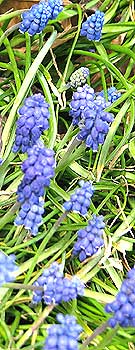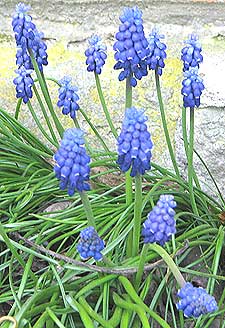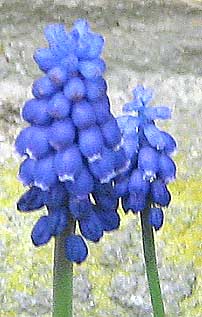Muscari, GRAPE HYACINTH - Growing from Bulbs
POPLUAR VARIETIES GRAPE HYACINTH
The most well- known species is Muscari armeniacum, especially in its variety Heavenly Blue, with rich blue flowers. Another good variety is Cantab, with paler, Cambridge-blue flowers. These flowers are borne in racemes on stems some 8 inches tall.

Other grape hyacinths with especial charm
and garden value are M. botryoides album, a
pure white Muscari only 6in. tall and very pretty in April and May when
flowering freely.
The Musk Hyacinth, M. moschatum is worth growing for the sake of its fragrant, purplish- blue flowers; the variety named Flavum, which bears yellow flowers flushed with purple, is also fragrant and to be recommended for the sake of its distinct colouring.
For March-April flowering
there is the rather unusual and splendid M. tubergenianum
which has flowers in two shades of blue on each spike—pale
blue at the
top, dark blue lower down.
Another is the Plume or Feather
Hyacinth, M. comosum monstrosum,
or, as it is usually listed in catalogues, M. c. plumosum. The violet-coloured
flower spikes of this variety
have a feathery appearance and are altogether looser than those of the
other muscari and it looks very effective on a sunny ledge in the rock
garden.
PLANT SOCIETIES
MUSCARI (GRAPE HYACINTH)
 Grape Hyacinths or Muscari
are hardy spring flowering bulbs which grow wild in Southern Europe and
Asia. They belong to the lily family.
Grape Hyacinths or Muscari
are hardy spring flowering bulbs which grow wild in Southern Europe and
Asia. They belong to the lily family.
Grape Hyacinths are grown from bulbs and bear grape like clusters of mostly blue flowers on erect stems.
They are splendid plants for borders, growing around trees or shrubs on rock gardens, and naturalising in grass.
PLANTING GRAPE HYACINTH BULBS
Plant Muscari in ordinary soil in sunny positions.
Grape Hyacinth bulbs must be planted early. To ensure a satisfactory display of bloom during the first spring, it is necessary to plant the bulbs as early as possible in the autumn, for they start into growth far sooner than most other spring flowering bulbs.
They should be set in the ground in August or early September; their leaves will then appear above ground in a few weeks.
If planting is delayed until late autumn or early winter, the bulbs will have little chance to become well rooted before the cold weather sets in, and their chances of providing a first- rate show of bloom during the first year will be jeopardised.
HOW DEEP TO PLANT MUSCARI BULBS
The Grape Hyacinth bulbs should be set about 3 inches apart and at such a depth that the tops are covered by 2 inches of soil.
The Muscari Bulbs may be left undisturbed for many years—until they become so crowded that they fail to bloom freely.
HOW TO LIFT GRAPE HYACINTH BULBS?
When it becomes necessary to lift and separate the bulbs, the work should be done as soon as the leaves have turned yellow.
The clumps of Muscari should then be taken up and separated into single bulbs and graded in sizes before they are replanted ; the smaller ones could then be grown for a year on a reserve border and the larger ones set out in their permanent places.
WHERE IS THE BEST PLACE TO PLANT GRAPE HYACINTHS?
The Muscari are not so suitable for planting in formal flower beds as many other bulbs, for they form large leafy masses which become untidy; they are seen at their best in the less formal parts of the garden as, for instance, in open spaces among shrubs, on the outskirts of the rock garden, on grassy banks, and in half-wild places.
There they will flourish and spread, by means of self-sown seeds, as well as by offsets, and annually produce a feast of flowers.
COLOUR SCHEMES WITH MUSCARI AND FLOWERING SHRUBS
The Grape Hyacinths provide an admirable ground covering beneath some of the spring flowering shrubs, particularly the Golden Bell or Forsythia, and the Star Magnolia.
The former has yellow and the latter white flowers, and the blue of the Grape Hyacinth associates perfectly with both of them.
They are delightful also when massed beneath one of the pink- flowered ornamental Cherries
MUSCARI FOR THE UNHEATED GREENHOUSE
 The Grape Hyacinths are suitable for cultivation in pots in an unheated
greenhouse, where they will be in full beauty in March.
The Grape Hyacinths are suitable for cultivation in pots in an unheated
greenhouse, where they will be in full beauty in March.
The bulbs ought to be set in pots of sandy, loamy soil in September and kept in a cold, shady frame for 5—6 weeks until the pots are full of roots, or they may be placed out of doors on a paved or asphalt path and covered with old, sifted ashes.
When well rooted, the plants should be placed in the greenhouse.
Gardeners who are anxious to have flowers in their cold greenhouses in early spring will find the Grape Hyacinths beautiful and easily grown flowering bulbs that provide a wealth of bloom.
FOR BOWL CULTIVATION.
Muscari may also be grown in bowls of fibre in the home.
GARDENING ADVICE ARTICLES ON GARDEN GROWER
How to grow Grape Hyacinths or Muscari - advice about growing these pretty blue spring flowers from bulbs